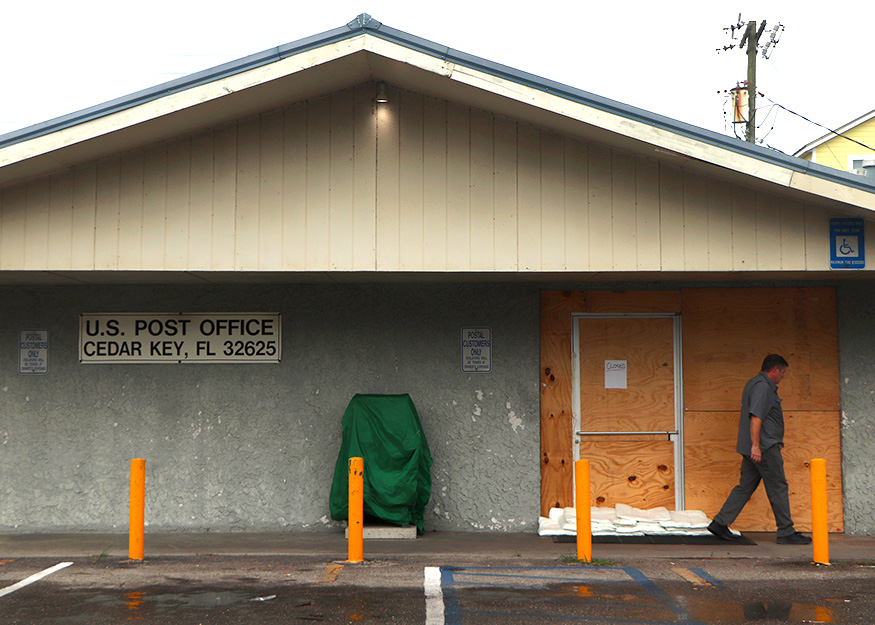CEDAR KEY, Fla. – Ahead of Hurricane Idalia’s landfall, expected early Wednesday, residents of this historic, Gulf coast fishing village renowned for its waterfront seafood restaurants and quaint stores were wondering whether their luck was about to run out.
On the edge of the Gulf of Mexico, windows were boarded Tuesday, businesses were empty and cars were missing from driveways. A few people on golf carts drove along the island’s roads ahead of the storm – just before an evacuation.
Forecasters predicted the storm would strengthen to at least a Category 3 hurricane before landfall, with storm surges of up to 10 to 15 feet.
Disaster planners who have studied Cedar Key’s housing and community vulnerabilities have predicted that a Category 3 storm could overwhelm over 80% of homes on the island and cripple nearly all its critical infrastructure.
Corey and Samuel Rudd, 26 and 17, were clearing the porch of a home on State Road 24 heading into Cedar Key and said they had been putting up storm shutters for a few days. Their grandfather owns the business where they work, Taylor Construction and Development Inc. Grandma was leaving to shelter in Gainesville, about 60 miles northeast. Grandpa was staying behind.
The city’s postmaster of 13 years, Jason Knott, kept busy clearing the front of the store to keep debris from turning into a missile. Last year, he said, the town prepared for Hurricane Ian to devastate until that storm turned east. “Really dodged a bullet,” he said. Knott lives in Ocala and was planning to shelter there for the night but will return Wednesday to check the damage and rebuild, as he always has.
Lydia Hicks, 62, has lived in Cedar Key for two years but has known the city since childhood through her great grandparents. She works now as a catastrophe insurance adjuster and knows the strength of storms like these. She is not worried so much about the storm surge as she is the strength of the storm winds, which have a chance to intensify. Hicks said she will shelter in Port Richey, north of Tampa, for the night.
A bad omen for Cedar Key? The Weather Channel’s journalist who famously reports from the likely bullseye of the strongest hurricanes, Jim Cantore, was broadcasting from the town for much of the day Tuesday.
Cedar Key only has an area of about two miles. In 2020, it had fewer than 700 residents and 400 total households, according to Census figures.
Forecasters said Hurricane Idalia shifted late Tuesday evening further west than Cedar Key than originally expected. It’s not the first time it’s had a close call with a major storm. Hurricane Ian in 2022, less than a year ago, was just shy of Category 5 status upon landfall and was initially predicted to hit Cedar Key, but instead shifted south of Tampa, relieving residents.
The last major hurricanes to land near Cedar Key in 100 years were Hurricane Easy in 1950 and an unnamed storm in 1935. Hurricane Hermine devastated Cedar Key with a record six feet of storm surge in 2016. Idalia could be twice as bad, the National Hurricane Center said.
In a home on the island, a lone golf cart sat in the driveway Tuesday, morbidly decorated with two skeletons in the back seat facing the road. No one was home.
Tom, who would not give his last name, was walking his dog, Daisy, before leaving town for the night. In his neighborhood on the northwest side of the island, he said, it hasn’t flooded at all in the past two years he has lived there. He’s bringing a box of valuables with him but didn’t expect there to be much damage when he comes back tomorrow.
North of Cedar Key, in the flood-prone Big Bend of Florida and Apalachee Bay, the National Weather Service said a storm surge in this part of Florida would be unprecedented, with unknown consequences.
“Looking back through recorded history, NO major hurricanes have ever moved through the Apalachee Bay,” the weather service said in a bulletin. “When you try to compare this storm to others, DON’T. No one has seen this.”
Calm Before Storm: Historic Florida Fishing Village Prepares for Historic Hurricane Surge
Tools
Typography
- Font Size
- Default
- Reading Mode


